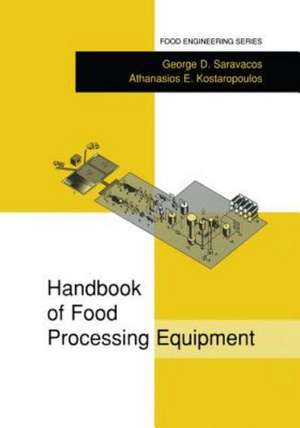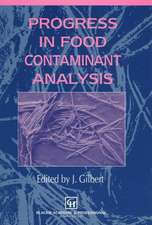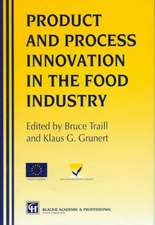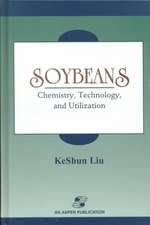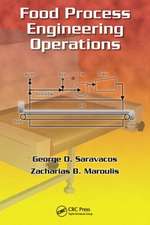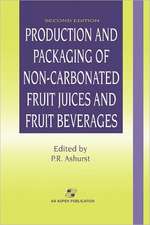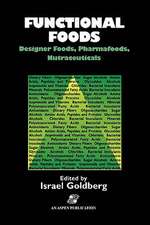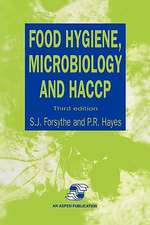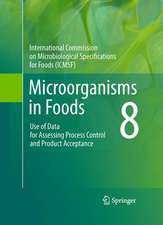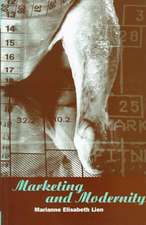Handbook of Food Processing Equipment: Food Engineering Series
Autor George D. Saravacos, Athanasios E. Kostaropoulosen Limba Engleză Paperback – 21 sep 2012
| Toate formatele și edițiile | Preț | Express |
|---|---|---|
| Paperback (1) | 973.06 lei 6-8 săpt. | |
| Springer Us – 21 sep 2012 | 973.06 lei 6-8 săpt. | |
| Hardback (1) | 1157.31 lei 38-44 zile | |
| Springer – 30 ian 2003 | 1157.31 lei 38-44 zile |
Din seria Food Engineering Series
- 18%
 Preț: 980.95 lei
Preț: 980.95 lei - 15%
 Preț: 642.51 lei
Preț: 642.51 lei - 15%
 Preț: 647.92 lei
Preț: 647.92 lei - 23%
 Preț: 856.71 lei
Preț: 856.71 lei - 15%
 Preț: 647.40 lei
Preț: 647.40 lei - 15%
 Preț: 646.30 lei
Preț: 646.30 lei -
 Preț: 384.86 lei
Preț: 384.86 lei - 18%
 Preț: 966.78 lei
Preț: 966.78 lei - 18%
 Preț: 1236.38 lei
Preț: 1236.38 lei - 15%
 Preț: 656.74 lei
Preț: 656.74 lei - 15%
 Preț: 653.33 lei
Preț: 653.33 lei - 18%
 Preț: 951.59 lei
Preț: 951.59 lei - 18%
 Preț: 944.99 lei
Preț: 944.99 lei - 15%
 Preț: 716.15 lei
Preț: 716.15 lei - 18%
 Preț: 1232.57 lei
Preț: 1232.57 lei - 15%
 Preț: 647.92 lei
Preț: 647.92 lei - 15%
 Preț: 587.85 lei
Preț: 587.85 lei - 18%
 Preț: 1222.80 lei
Preț: 1222.80 lei - 18%
 Preț: 952.09 lei
Preț: 952.09 lei - 18%
 Preț: 1398.31 lei
Preț: 1398.31 lei -
 Preț: 399.12 lei
Preț: 399.12 lei - 18%
 Preț: 954.14 lei
Preț: 954.14 lei - 15%
 Preț: 644.95 lei
Preț: 644.95 lei - 18%
 Preț: 968.65 lei
Preț: 968.65 lei - 15%
 Preț: 638.89 lei
Preț: 638.89 lei - 18%
 Preț: 962.49 lei
Preț: 962.49 lei - 18%
 Preț: 1008.25 lei
Preț: 1008.25 lei - 18%
 Preț: 1225.79 lei
Preț: 1225.79 lei - 18%
 Preț: 961.41 lei
Preț: 961.41 lei - 18%
 Preț: 1378.86 lei
Preț: 1378.86 lei - 18%
 Preț: 961.72 lei
Preț: 961.72 lei -
 Preț: 489.30 lei
Preț: 489.30 lei - 18%
 Preț: 1388.05 lei
Preț: 1388.05 lei - 18%
 Preț: 1235.08 lei
Preț: 1235.08 lei - 15%
 Preț: 643.34 lei
Preț: 643.34 lei - 18%
 Preț: 2109.71 lei
Preț: 2109.71 lei - 18%
 Preț: 1815.87 lei
Preț: 1815.87 lei - 15%
 Preț: 644.95 lei
Preț: 644.95 lei - 18%
 Preț: 957.32 lei
Preț: 957.32 lei
Preț: 973.06 lei
Preț vechi: 1186.66 lei
-18% Nou
Puncte Express: 1460
Preț estimativ în valută:
186.22€ • 193.70$ • 153.73£
186.22€ • 193.70$ • 153.73£
Carte tipărită la comandă
Livrare economică 14-28 aprilie
Preluare comenzi: 021 569.72.76
Specificații
ISBN-13: 9781461352129
ISBN-10: 1461352126
Pagini: 728
Ilustrații: XXIV, 698 p.
Dimensiuni: 178 x 254 x 38 mm
Greutate: 1.24 kg
Ediția:Softcover reprint of the original 1st ed. 2002
Editura: Springer Us
Colecția Springer
Seria Food Engineering Series
Locul publicării:New York, NY, United States
ISBN-10: 1461352126
Pagini: 728
Ilustrații: XXIV, 698 p.
Dimensiuni: 178 x 254 x 38 mm
Greutate: 1.24 kg
Ediția:Softcover reprint of the original 1st ed. 2002
Editura: Springer Us
Colecția Springer
Seria Food Engineering Series
Locul publicării:New York, NY, United States
Public țintă
ResearchCuprins
1—Design of Food Processes and Food Processing Plants.- I. Introduction.- II. Overview of Chemical Process and Plant Design.- III. Design of Food Processes.- IV. Food Plant Design.- References.- 2—Design and Selection of Food Processing Equipment.- I. Introduction.- II. Sizing and Costing of Equipment.- III. Materials of Construction.- IV Fabrication of Equipment.- V. Hygienic Design of Food Processing Equipment.- VI. Selection of Food Processing Equipment.- Directories of Equipment.- Directories of Food Equipment.- Exhibitions of Food Process Equipment.- References.- 3—Mechanical Transport and Storage Equipment.- I. Introduction.- II. Mechnical Transport Equipment.- III. Food Storage Equipment.- References.- 4—Mechanical Processing Equipment.- I. Introduction.- II. Size Reduction.- III. Size Enlargement.- IV Homogenization.- V. Mixing and Forming.- References.- 5—Mechanical Separation Equipment.- I. Introduction.- II. Classification Operations.- III. Solid/Solid Separations.- IV. Solid/Liquid Separators.- V. Solid/Air Separators.- VI. Removal of Food-Related Parts.- References.- 6—Heat Transfer Equipment.- I. Introduction.- II. Heat Transfer Coefficients.- III. Empirical Correlations of h.- IV. Heat Exchangers.- References.- 7—Food Evaporation Equipment.- I. Introduction.- II. Heat Transfer in Evaporators.- III. Food Quality Considerations.- IV. Food Evaporators.- V Energy-Saving Evaporation Systems.- VI. Evaporator Components.- References.- 8—Food Dehydration Equipment.- I. Introduction.- II. Principles of Drying.- III. Design and Selection of Food Dryers.- IV. Energy and Cost Considerations of Drying.- References.- 9—Refrigeration and Freezing Equipment.- I. Introduction.- II. Refrigeration Equipment.- III. Cooling of Foods.- IV Freezing of Foods.-V. Cold Storage.- VI. Ice Manufacturing.- References.- 10—Thermal Processing Equipment.- I. Introduction.- II. Kinetics of Thermal Inactivation.- III. Heat Transfer Considerations.- IV. Thermal Process Calculations.- V. Thermal Processing Equipment.- References.- 11—Mass Transfer Equipment.- I. Introduction.- II. Distillation Equipment.- III. Solvent Extraction/Leaching Equipment.- IV Gas/Liquid Absorption Equipment.- V. Adsorption and Ion-Exchange Equipment.- VI. Crystallization from Solution Equipment.- References.- 12—Equipment for Novel Food Processes.- I. Introduction.- II. Membrane Separation Equipment.- III. Supercritical Fluid Extraction.- IV Crystallization from Melt.- V. Nonthermal Food Preservation.- References.- 13—Food Packaging Equipment.- I. Introduction.- II. Preparation of Food Containers.- III. Filling Equipment.- IV. Closing Equipment.- V. Aseptic Packaging.- VI. Group Packaging.- References.- Appendix A—Notation and Conversion of Units.- Appendix B—Selected Tbermopbysical Properties.- Appendix C—Control of Food Processing Equipment.- Appendix D—Food Plant Utilities.- Appendix E—Manufacturers and Suppliers of Food Equipment.
Caracteristici
serve as a resources for food process engineering students
Descriere
Descriere de la o altă ediție sau format:
Recent publications in food engineering concern mainly food process engi neering, which is related to chemical engineering, and deals primarily with unit operations and unit processes, as applied to the wide variety of food processing operations. Relatively less attention is paid to the design and operation of food processing equipment, which is necessary to carry out all of the food processes in the food plant. Significant technical advances on processing equipment have been made by the manufacturers, as evidenced by the efficient modem food pro cessing plants. There is a need to relate advances in process engineering to proc ess equipment, and vice versa. This book is an attempt to apply the established principles of transport phe nomena and unit operations to the design, selection, and operation of food pro cessing equipment. Since food processing equipment is still designed empiri cally, due to the complexity of the processes and the uncertainty of food properties, description of some typical industrial units is necessary to understand the operating characteristics. Approximate values and data are used for illustra tive purposes, since there is an understandable lack of published industrial data.
Recent publications in food engineering concern mainly food process engi neering, which is related to chemical engineering, and deals primarily with unit operations and unit processes, as applied to the wide variety of food processing operations. Relatively less attention is paid to the design and operation of food processing equipment, which is necessary to carry out all of the food processes in the food plant. Significant technical advances on processing equipment have been made by the manufacturers, as evidenced by the efficient modem food pro cessing plants. There is a need to relate advances in process engineering to proc ess equipment, and vice versa. This book is an attempt to apply the established principles of transport phe nomena and unit operations to the design, selection, and operation of food pro cessing equipment. Since food processing equipment is still designed empiri cally, due to the complexity of the processes and the uncertainty of food properties, description of some typical industrial units is necessary to understand the operating characteristics. Approximate values and data are used for illustra tive purposes, since there is an understandable lack of published industrial data.
